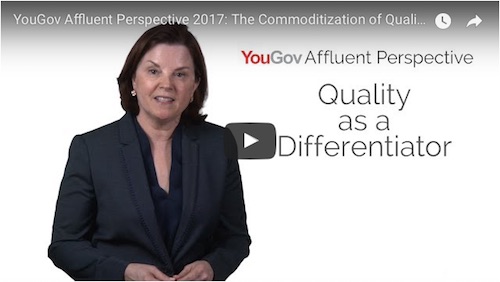Articles and News
When Quality Alone Isn’t Enough, It’s Intangibles That Sell Luxury | July 12, 2017 (0 comments)

Cheshire, CT—The Oxford Dictionary defines luxury as “the state of great comfort and extravagant living.”
While most people would agree that comfort is a key component of luxury, increasingly, extravagant living isn’t how affluent consumers define their personal luxury. Of course, one person’s extravagance is another’s necessity, but inconspicuous consumption is still holding strong among the affluent. Meanwhile, as both good quality and good design are no longer the exclusive domain of luxury goods and both are equally accessible in mainstream brands, affluent consumers are turning to less tangible attributes to drive their purchasing decisions for luxury products.
Conspicuous consumption; i.e. using material objects to convey social position and status, is far from dead, but with luxury goods—and credit—significantly more accessible to the masses today than they once were, carrying a status handbag or driving a luxury car isn’t necessarily a badge of real wealth. The Great Recession put the brakes on conspicuous consumption among the affluent, regardless of whether they were personally impacted. Those who were reined in spending out of necessity; those who weren’t reined in spending to keep a low profile and not be perceived as flaunting their wealth.
But behind the modesty there’s still snobbery, just in plainer clothes. In a recent essay for Aeon, Elizabeth Currid-Halkett, professor of public policy at the University of Southern California and the author of The Sum of Small Things: A Theory of the Aspirational Class, says the democratization of luxury goods has driven the rise of inconspicuous consumption. Not that the super-rich don’t still buy Bentleys or yachts, but Currid-Halkett sees dramatic changes among what she calls the aspirational class: a well-to-do, educated, elite group that prizes a more understated, but no less exclusionary, badge of position. When anyone with a high enough credit card limit can obtain luxury products, this group cements its status through spending on education and services—what she calls “cultural capital”—over ostentatious material goods.
For instance, the cost of college tuition increased 80% from 2003 to 2013, while the cost of women’s apparel increased just 6% in the same 10-year period. Splurging $1,500 on a Louis Vuitton bag is a far cry from funding a $200,000+ tab for four years at a private university, so tucking a copy of The Economist into one’s bag and being able to knowledgeably discuss its contents at a cocktail party is a hallmark of costly education and shorthand to convey membership in the elite class that can afford it.
Getting back to an actual definition of luxury, the 2017 YouGov Affluent Perspective Study, an annual look at the attitudes and shopping habits of the global affluent, left it up to each individual respondent to decide what luxury means to them. Universally, affluent consumers do agree that to qualify as “luxury,” goods and services must be superior to their non-luxury counterparts, and it goes without saying that they must be of exceptional quality.
But as the study reveals, quality has become less exceptional and more ubiquitous and excellent quality is no longer the sole province of high-end goods. YouGov’s Chandler Mount points out that while luxury brands have been expanding their circles to include more of the mass affluent, mass brands are upping their standards to compete, and the world’s wealthiest households recognize that many non-luxury brands offer highly refined products and experiences without the luxury price tag. He uses Hyundai automobiles as an example: the brand offers well-appointed cars with refined finishes and recent—though not cutting-edge—technology, all for about 2/3 the price of a luxury brand.
While luxury traditionally has been synonymous with exceptional quality, and exceptional quality with higher prices, the distinction is waning, says YouGov. Many affluent consumers (71% of North American respondents to the YouGov study) believe mainstream luxury brands like Coach, Hyundai, or Brooks Brothers offer a level of quality comparable to ultra-high luxury brands like Gucci or Louis Vuitton.
So if high-end luxury is no longer solely dependent on higher quality—and indeed, sometimes high-end luxury products don’t even perform as well as their mainstream counterparts—what drives luxury brand purchases?
Old-fashioned snob appeal still has relevance (see above), just not as much as it used to. 61% of YouGov’s respondents said they like brands that make them feel successful; 58% said they like brands that make them feel privileged; and 57% like brands that make them feel like they own something rare.
Today it’s more important for brands to resonate with customers on a more personal level. 81% of YouGov’s respondents want brands that share their values, and 82% want brands they feel they can relate to. And most of all, they want validation: 89% said they want brands that make them feel confident they’ve made a good choice.
“The affluent are searching for brands that seem honest and make them feel confident in their decisions. In other words, brands they can trust, brands that are competent and consistent, and brands that won’t let them down,” says Cara David, YouGov managing partner. “Luxury brands [and retailers] that can harness these intangible qualities—above and beyond the ability to provide quality products and experiences—can expect more affluent customers to walk through their door.”
"Designer jewelry and watch buyers who spend $2,500 or more on a single piece are motivated by brands that help them embrace their success and deliver products that fit with their broader needs," David told The Centurion. "Building a solid relationship with these customers requires a general understanding of the life they live and what they value."
Qualitative research of customers can help build a solid base to develop the right general approach, she says. Coupled with database-driven insights specific to each customer it can lead to more frequent connections and stronger alignment on customers’ values. "The affluent today want brands [and retailers] that fit them, not the other way around," she says.
For jewelers' longtime clients, chances are you already know their significant dates and milestone events. And chances are you know a lot more than that: their hobbies and passions, what causes and charities they support, and you probably have a fairly good idea of their overall values just from conversations and years of acquaintance. But what about new clients?
"Affluent consumers are increasingly focused on transparency in business. They prefer clarity to obscurity in the buying process, and the emotional outcome from even the smallest interaction (never mind, purchase) can influence a lifetime of behavior," says David. "It starts with the store. It continues with the selection. It’s reinforced by the staff. It’s sealed by the post-purchase moments." She offers these tips:
- Retail stores should engage all five senses for their customers (sights, sounds, smells, textures, and when possible, taste). Today’s buyers want a store experience that is fun, relaxing, and most importantly, meticulous.
- Product selection may be different from location to location, but the essence of the brand should be similar no matter where you go. We think it’s better to have a lot of one type of customer than a lot of customers who all have different needs. This approach helps the customer answer the question “is this store for people like me?” And it influences staff selection and training.
- The most effective staff will be the embodiment of the brand’s personality. They should love what they do because it gives them satisfaction and fulfillment. Affluent customers want to know that the person they are working with is happy with their career.
- The next sale starts right after the first sale is completed. Successful brands and retailers will take care to follow up with a simple communication that shows gratitude for the customer’s purchase and well wishes for their enjoyment of the piece.
Click here or on the image below to watch a video with Cara David explaining the latest YouGov Affluent Perspective Study findings about attitudes toward quality. Brands and retailers also can sign up for the Affluent Perspective newsletter at www.affluentperspective.com.
Top image: Princeton University








